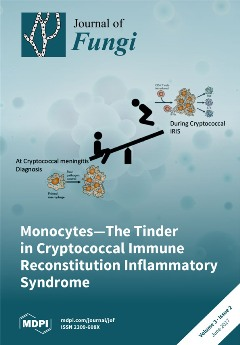We evaluated the expression of biomarkers of innate and adaptive immune response in correlation with underlying conditions in 144 patients with chronic pulmonary aspergillosis (CPA). Patients with complete medical and radiological records, white cell counts, and a complete panel of CD3, CD4, CD8,
[...] Read more.
We evaluated the expression of biomarkers of innate and adaptive immune response in correlation with underlying conditions in 144 patients with chronic pulmonary aspergillosis (CPA). Patients with complete medical and radiological records, white cell counts, and a complete panel of CD3, CD4, CD8, CD19, and CD56 lymphocyte subsets were included. Eighty-four (58%) patients had lymphopenia. Six (4%) patients had lymphopenia in all five CD variables. There were 62 (43%) patients with low CD56 and 62 (43%) patients with low CD19. Ten (7%) patients had isolated CD19 lymphopenia, 18 (13%) had isolated CD56 lymphopenia, and 15 (10%) had combined CD19 and CD56 lymphopenia only. Forty-eight (33%) patients had low CD3 and 46 (32%) had low CD8 counts. Twenty-five (17%) patients had low CD4, 15 (10%) of whom had absolute CD4 counts <200/μL. Multivariable logistic regression showed associations between: low CD19 and pulmonary sarcoidosis (Odds Ratio (OR), 5.53; 95% Confidence Interval (CI), 1.43–21.33;
p = 0.013), and emphysema (OR, 4.58; 95% CI; 1.36–15.38;
p = 0.014), low CD56 and no bronchiectasis (OR, 0.27; 95% CI, 0.10–0.77;
p = 0.014), low CD3 and both multicavitary CPA disease (OR, 2.95; 95% CI, 1.30–6.72;
p = 0.010) and pulmonary sarcoidosis (OR, 4.94; 95% CI, 1.39–17.57;
p = 0.014). Several subtle immune defects are found in CPA.
Full article






